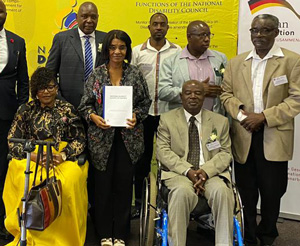
Creating access for all

By Deutsche Gesellschaft fuer Internationale Zusammenarbeit (GIZ).
Imagine every day and every activity being a challenge or simply not being able to take part in everyday life. People with disabilities face this prospect daily, simply because buildings and infrastructure have not been made with them in mind.
Leaving buildings, offices, schools, shops and infrastructure inaccessible to them because of lack of wheelchair access for example. This is why in the spirit of Leave No One Behind (LNOB) a Disability Accessibility Standard for all Public Buildings and Infrastructure has been created in Namibia. This Standard was launched during a workshop for stakeholders in March of this year, in Windhoek.
The key mandate of the National Disability Council of Namibia (NDCN) is to Improve the lives of People with Disabilities, and to create a Barrier Free Society for the 100,000 people in Namibia with disabilities.
It is vital that the principle of ‘Leave No One Behind’ includes people that have disabilities. That is why the NDCN has taken the steps, to develop a Disability Standards for Public Buildings and Facilities. This standard provides guidelines and specifications for auditing and inspecting facilities.
When speaking about Namibia, we often speak of the Namibian House and there needing to be room for every Namibian and how it needs to be welcoming safe and a place to thrive. Now, imagine some of the population not being able to get through the front door of the ‘House’ due to wheelchair inaccessibility or getting passed the stairs, as there’s no lift. Simply not knowing if you are in the correct building, as there’s no braille signage anywhere.
The lack of sign language interpreters, braille documents, information and communication and other assistive devices at our court houses, police stations, hospitals, schools, governmental and private institutions limit the ability of persons with disabilities to effectively participate in the Namibian House.
These hurdles and more need to be removed so that the Namibian house is truly all embracing for each citizen. This is in short what the Disability Accessibility standard looks to rectify and change.
The majority of buildings, infrastructure, restaurants, gyms, shops, libraries museum and other facilities in Namibia are just not made with disability accessibility standards in mind. This is due to the fact that the buildings were built well before the accessibility standards were developed.
Mr. Tjiueza Tjombumbi from the NDCN said that the Disability Accessibility Standard will not only benefit those with disabilities in Namibia, but also those in Africa and the tourists beyond the Sub-Saharan Africa region coming to Namibia. When we visit their countries, we benefit from their accessible infrastructures, visitors should also benefit from our universal design when they visit Namibia.
In his keynote address at the launch of disability accessibility standard Honorable Sankwasa James Sankwasa, the then Deputy Minister of Works and Transport stated that all OMAS, private entities and development partners should take note that, public funds must not be used to discriminate against anybody. The principle of “LNOB” of Agenda 2030, must be put into practice in planning, executions and monitoring and evaluation of our projects and activities. No one should feel left out.”
Dr. Steytler, leader of the Sustainable Development Goals Initiative at GIZ Namibia, during his remarks at the workshop commented on how pleased he was that different stakeholder groups such as; line Ministries, architects and project developers as well as representatives from the NDCN attended the workshop.
He was especially pleased that the architectural company of Marely Tjitjo Architects Incorporated have been so intrinsically involved with this process, as part of their corporate social responsibility program. The design of any building or infrastructural project should be founded on the principle that it must be accessible to everyone, regardless of their physical abilities. This has to become the new norm for architects and project developers.
To set an example GIZ Namibia recently upgraded some of its office infrastructure to ensure that it is accessible to persons with disabilities. Disability issues are important to GIZ Namibia and therefore they saw the need to fund this workshop under the auspices of the NDCN in March in Windhoek. GIZ Namibia will continue to work together with the relevant stakeholders such as the NDCN and Ministries to ensure that no one is ‘Left behind’ and that buildings and infrastructure in Namibia are accessible to everyone.









































